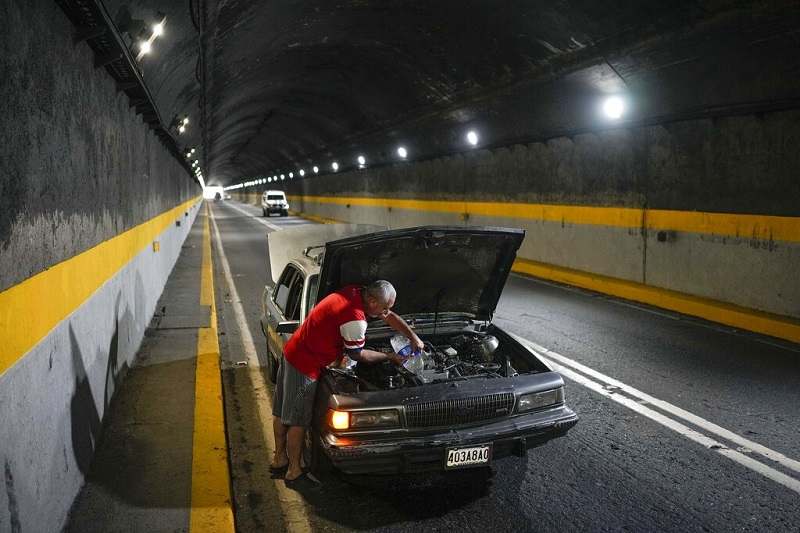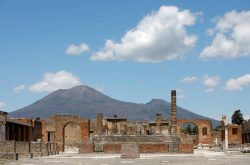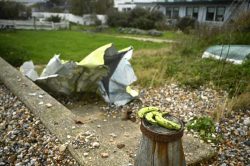
A man tries to cool down his overheating car by pouring water into the radiator, in one of the tunnels of the road that connects La Guaira with Caracas, Venezuela, Tuesday, April 19, 2022.
15:09 JST, May 22, 2022
CARACAS, Venezuela (AP) — A 1983 Chevrolet C-10 pickup is the workhorse of Argenis Ron’s party equipment rental business. He uses it to haul chairs, tents and tables to gatherings all across Venezuela’s sprawling capital.
The once-white paint is slightly yellowish and the body shows a bit of rust, a few dings. The odometer was already broken when he bought it 12 years ago.
And with business picking up as the pandemic seems to slow, he’s putting in more miles — and making more trips to mechanics, including a recent visit to investigate a snoring-like noise emanating from the left rear wheel.
“When the mechanics ask for parts — the truck asks you — you have to buy them,” Ron said. “One cannot refuse because the truck is a resource to make money.”
He’s philosophical about the need to keep repairing his vintage truck: “It’s not like the current cars that have a computer and have a lot of things at the system level. I say that (old trucks) are trustworthy and more reliable because they use nothing but gasoline and water.”
People like Ron are keeping Caracas’ street-corner mechanics increasingly busy these days as they try to coax a little more life out of aging vehicles in a country whose new car market collapsed and where few can afford to trade up for a better used one.
Venezuela’s vehicle industry produced only eight trucks last year — and nary a single car — according to the Chamber of Venezuelan Manufacturers of Automotive Products. At the century’s peak, in 2006-2007, some 172,000 vehicles rolled out of plants operated by Ford, General Motors, Toyota, Mitsubishi, Chrysler and others.
Imports haven’t filled the gap. In 2021, only 1,886 new light vehicles were sold in Venezuela, according to estimates from LMC Automotive, an auto industry consulting firm. That was about double the number in 2020, but less than 1% of what was sold in 2007, when new light vehicle sales peaked at 437,675.
Venezuela lifted a ban on importing used cars in 2019. But years of hyperinflation obliterated much of the middle class that could once dream at least of a used car, leaving average monthly salaries at less than $100. That inflation combined with government controls meant to stifle it also meant banks were unwilling or unable to make car loans.
So people cling to what they have. Like Eduardo Ayala’s 1999 Nissan Sentra, which was undergoing mechanical surgery at a shop in a working class district in western Caracas.
“It wasn’t that I chose that car, it was that I had the money for that car,” Ayala said. “I would like to buy a (Suzuki) Grand Vitara, at least a 2005, (but) you also have to adjust to your economy as much as you can.”
Elvis Hernandez found the problem that had left Ayala stranded on the freeway a day earlier: A month-old off-brand ignition distributor had failed.
“The vast majority of people do not have money to buy a car — that is the truth of the matter. So they prefer to repair the one they have,” Hernandez said. Around him, fellow mechanics worked on other cars, all at least a decade old.
Venezuela’s roads are full of high-mileage, money-sucking vehicles, many that predate the socialist transformation ushered in by the late President Hugo Chavez at the turn of the century.
A morning commute to work, a brief trip to the grocery store or a 14-mile drive to the beach all involve sightings of cars parked with someone tinkering under the hood.
Venezuela — with one the world’s largest reserves of crude oil — once had the most prosperous middle class in Latin America and car dealerships boomed.
But a complex social, economic and humanitarian crisis began in the mid-2010s, aggravated by falling oil prices, U.S. economic sanctions on the government and — critics allege — flamboyant mismanagement of the economy.
In 2020, about nine out of 10 families once ranked as middle class had fallen into the ranks of the poor, according to the Inter-American Development Bank. By one measure, the monthly income of those once-middle-class households fell from the equivalent of $830 a month in 2012 to $195 in 2020.
Many of the spacious dealerships that once catered to them still bear their logos, but now sit empty or house other businesses. Those open in the capital tend to target the upper class. A Ferrari dealership has three red cars on the floor, each costing more than $400,000.
Some Venezuelans have turned to YouTube for instruction on fixing their own cars.
Somewhere in Caracas is a Honda Civic with a PVC pipe acting as a hose and a piece of wood holding the battery in place. It broke down on the freeway after a holiday weekend, stranding all four swimsuit-wearing passengers and prompting them to improvise a repair as sweat streamed down their sand-dusted faces.
Others can still scrape together money to hire experts of varying degrees.
Dozens of mechanics operate along the street in the neighborhood where Ron, the equipment rental business owner, had his truck repaired, They keep their tools locked away in nearby buildings or other hideaways.
Enderson Ramirez, who specializes in brake systems, said some people have put off repairs for so long that they show up with broken brake pads and severely damaged discs.
He said that some vehicle owners may fix damaged rear brakes but “they put off doing the brakes in the front because their budget is not enough,” he said. “And, well, we negotiate with them. We negotiate the labor costs because … if he doesn’t get the work done, we don’t earn anything.”
"News Services" POPULAR ARTICLE
-

American Playwright Jeremy O. Harris Arrested in Japan on Alleged Drug Smuggling
-

Japan’s Nikkei Stock Average as JGB Yields, Yen Rise on Rate-Hike Bets
-

Japan’s Nikkei Stock Average Licks Wounds after Selloff Sparked by BOJ Hike Bets (UPDATE 1)
-

Japanese Bond Yields Zoom, Stocks Slide as Rate Hike Looms
-

Japan’s Nikkei Stock Average Buoyed by Stable Yen; SoftBank’s Slide Caps Gains (UPDATE 1)
JN ACCESS RANKING
-

Keidanren Chairman Yoshinobu Tsutsui Visits Kashiwazaki-Kariwa Nuclear Power Plant; Inspects New Emergency Safety System
-

Imports of Rare Earths from China Facing Delays, May Be Caused by Deterioration of Japan-China Relations
-

University of Tokyo Professor Discusses Japanese Economic Security in Interview Ahead of Forum
-

Japan Pulls out of Vietnam Nuclear Project, Complicating Hanoi’s Power Plans
-

Govt Aims to Expand NISA Program Lineup, Abolish Age Restriction

























